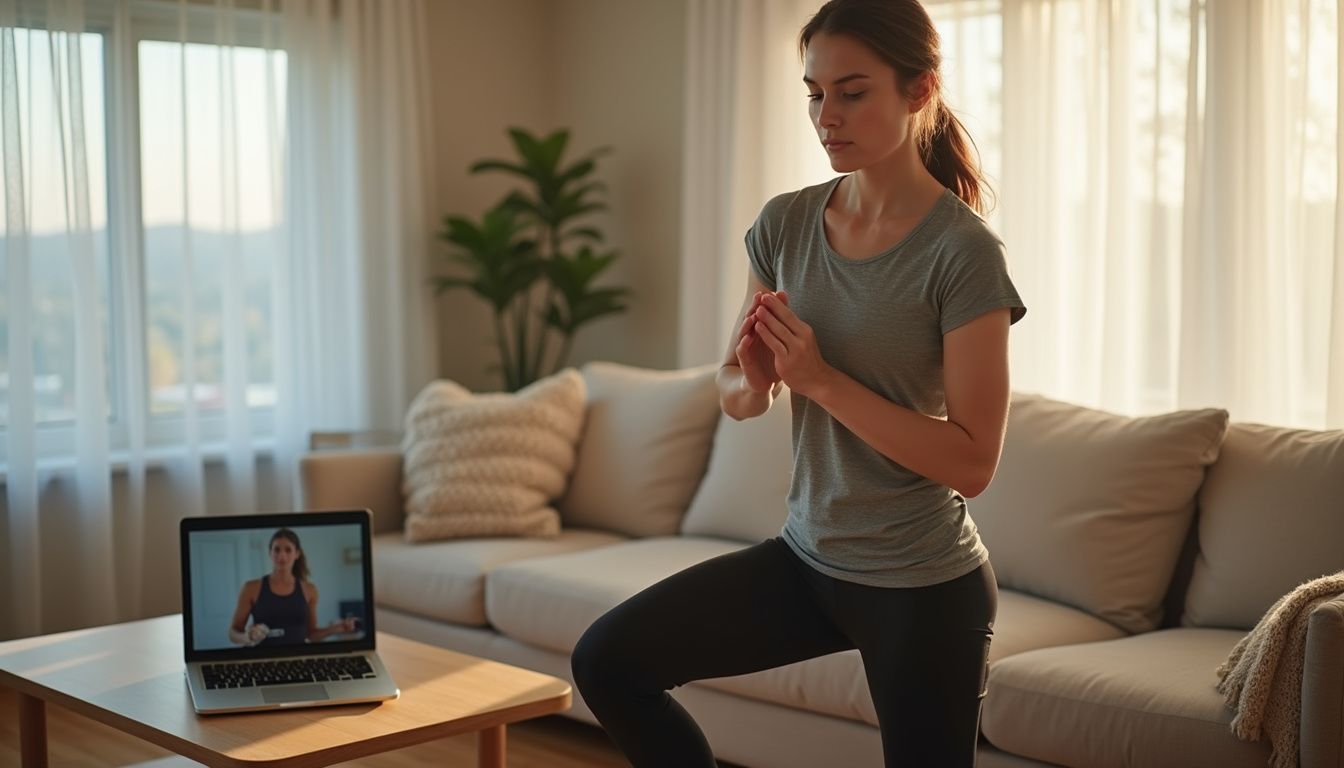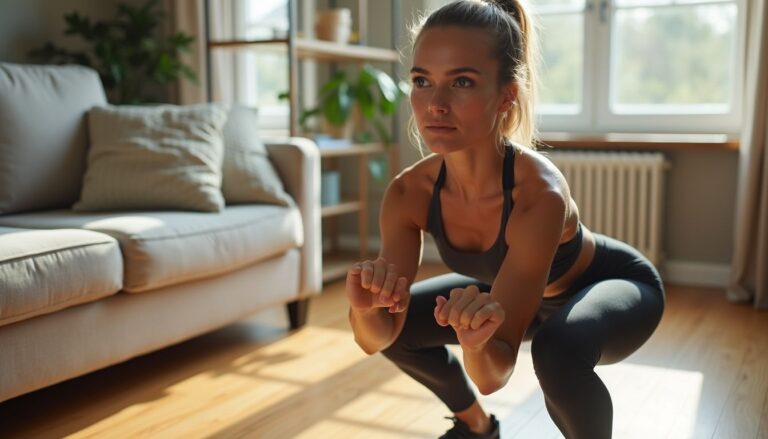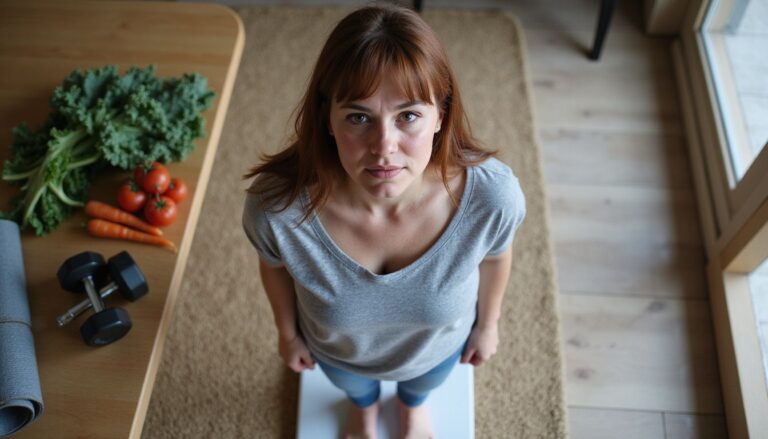Top Workout Exercises For Weight Loss At Home For Females
Our Nutrition Assistant AI Suite will transform your body. You will lose fat, get toned, and build muscle. Gain confidence and optimal health.
Trying to lose body fat at home can feel tough. Regular exercise raises calorie burn, supports heart health, and improves long-term weight management. The best exercise for weight loss at home depends on your goals, schedule, and fitness level.
This guide highlights simple workouts that work. You will find evidence-based tips, short routines, and clear steps you can start today. Small daily changes can build big momentum over time.
Keep reading if you want real change.
Key Takeaways
- High-intensity cardio moves such as jumping jacks, burpees, and jump rope can burn about 100 to 150 calories in ten minutes, which supports faster fat loss at home (Harvard Medical School).
- Strength training like squats, lunges, push-ups, and dumbbell deadlifts builds muscle. More muscle raises your metabolism, so each added pound can burn roughly 6 to 10 extra calories per hour.
- Core training, including planks, bicycle crunches, and Russian twists, improves posture and abdominal strength. The American Council on Exercise highlighted these as top ab moves in 2016.
- Low-impact options, such as yoga, Pilates, and Tai Chi, can burn up to 149 calories in 30 minutes for a 155-pound person, while being gentle on joints (Harvard Health, 2020).
- A balanced weekly plan that blends cardio and strength training helps motivation, reduces injury risk, and supports sustainable weight loss when paired with healthy eating.

Benefits of At-Home Workouts for Weight Loss

At-home workouts fit your life, cut travel time, and make daily movement easier. Consistent sessions raise calorie burn and physical fitness, all from your living room.
How do at-home workouts offer convenience and flexibility?
With home sessions, you set the time and style. Many people save 30 minutes or more by skipping the commute to a gym, as reported by the American Council on Exercise.
Short on time? Try a quick high-intensity interval training, often called HIIT. Prefer aerobic exercise? Jog in place or use a jump rope indoors. During early 2020, many Americans turned to indoor cycling, yoga, and bodyweight routines, proving how easy it is to adjust at home.
You can switch between brief workouts and longer sessions based on energy and schedule. Morning living room workouts help me start the day focused. That rhythm kept me consistent even when plans changed.
Choose the type of exercise, duration, and intensity that suits you, whether it is weight training, Pilates, or cardio. That flexibility helps you target major muscle groups and keep calorie burn steady with minimal gear.
You are more likely to stay committed to regular physical activity when it is easy to fit into your daily schedule.
Why are at-home workouts a cost-effective alternative to gyms?
Exercising at home cuts membership fees, gas costs, and class charges. A skipping rope, a mat, and a pair of dumbbells are often enough.
Effective weight loss exercises like squats, lunges, push-ups, and jump rope rely on body weight or simple tools that can cost under 50 dollars total. Many people spend more than 500 dollars per year on gym dues alone. Saving money often makes it easier to stay consistent.
There is no waiting for equipment. There is no travel. That means more sessions done and better progress toward your goals.
How does privacy and comfort improve workout effectiveness at home?
Privacy reduces distractions and stress. No lines, no crowd, and no pressure. Set the room temperature, play music you enjoy, and start your full-body workout on your terms.
I pushed harder at home and tried new moves like squats and push-ups because I felt comfortable. Wear what feels good, rest when needed, and move at a pace that suits you. This setting can improve consistency and help you burn calories more efficiently.
How can workouts be customized to individual fitness levels?
Adjust sets, reps, and rest to match your current ability. New to exercise? Try push-ups on your knees. More advanced? Use standard or decline push-ups to raise the challenge. A certified personal trainer can help you scale safely.
Control intensity with lighter weights or slower speed at first. Increase difficulty as your stamina grows to raise your basal metabolic rate, which is the energy your body uses at rest. I started with ten-minute sessions and built up, which kept me motivated without feeling overwhelmed.
The best exercise program is one that matches where you are right now so you stay consistent, says exercise physiologist Dr. Cedric Bryant from AARP.
High-intensity cardio exercises come next. These moves elevate heart rate and speed up fat loss.
High-Intensity Cardio Exercises
High-intensity cardio can boost your metabolism and increase calorie burn during and after your workout. Think of these moves as a spark that keeps burning for hours.
How do jumping jacks help with weight loss?
Jumping jacks work the upper and lower body at the same time. This raises heart rate quickly and leads to faster calorie burn in a short window.
Sports medicine data suggest that ten minutes of continuous high-intensity moves like jumping jacks can burn about 120 to 150 calories, depending on your size and effort. Cardiorespiratory fitness improves too, which supports heart and metabolic health. After adding five minutes of jacks to my mornings, I felt more energetic and saw the scale move slightly within two weeks.
The move uses body weight for resistance and helps with bone strength and core stability. For extra burn, pair jacks with burpees.
What are the benefits of doing burpees at home?
Burpees combine cardio and strength in one move. They keep your heart rate high and work many muscle groups, which raises total calorie burn.
No equipment is needed. Start with a few reps and add more as you get stronger. Research on high-intensity training shows larger fat reductions, especially compared to steady moderate work, due to higher post-exercise oxygen use. I saw stamina improve within a week and less belly fat after a month of morning burpees.
They are time efficient and fit into any routine.
How do mountain climbers improve fitness and burn calories?
Mountain climbers challenge your arms, legs, and core as you move quickly in a plank position. Think of it as horizontal running that demands control and speed.
This full-body effort can burn close to 100 calories in ten minutes for some people, based on body weight and intensity. It improves coordination and circulation while also building muscle endurance.
Why is jump rope an effective cardio exercise for weight loss?
Jump rope is a compact cardio workout with a strong calorie payoff. Harvard Medical School notes that a 155-pound person can burn about 125 calories in ten minutes of continuous jumping.
It raises heart rate fast and supports the circulatory system. Space needs are small, and equipment is affordable. Increase intensity by speeding up or using intervals. Adding jump rope boosted my coordination and stamina. It also helps people who need a simple way to create a calorie deficit.
Next, build strength to support a higher metabolic rate throughout the day.
Strength Training Exercises
Strength training builds muscle and supports weight loss. You can learn foundational movements at home with little or no gear.
How do squats build strength and aid weight loss?
Squats train large muscles in the legs, including the quadriceps, hamstrings, and glutes. Working big muscles increases calorie burn more than moves that target small areas.
Squats also drive muscle growth, called hypertrophy, which can raise resting metabolism. For each pound of muscle you gain, your body may burn an extra 6 to 10 calories per hour while at rest. Training squats can also improve joint function and the health of your tissues.
Start with bodyweight squats, for example 2 sets of 15 reps. Add a dumbbell or kettlebell after you master the movement to progress safely. You need only enough space to move with good form.
What are the best ways to do lunges for fat burning?
Begin with forward lunges. Step out, lower until both knees reach about 90 degrees, keep your torso tall, then push through the front heel to stand.
Try 10 to 15 reps per leg. Increase difficulty with dumbbells or add a gentle twist to engage your core. Rotate through static, walking, and side lunges to target your legs and glutes from different angles. Studies suggest that compound lower-body exercises can help create the calorie gap needed for weight loss, especially with smart nutrition.
A practical target is 2 to 4 sets of lunges within a 20 to 30 minute strength session that features rests between sets. Focus on control, not speed.
How can push-ups be modified for different fitness levels?
Push-ups scale well for everyone. New exercisers can start on the knees or against a wall to reduce load while learning form. As strength improves, shift to standard push-ups on the floor.
Already strong? Try incline push-ups using a bench, then progress to decline push-ups with feet elevated. Progressions keep the move challenging and effective for building muscle that supports weight loss.
Why include dumbbell deadlifts in a home workout routine?
Dumbbell deadlifts train the glutes, hamstrings, and lower back. Building these big muscles raises your daily calorie use, which helps you burn more calories than you eat.
This movement supports safe weight loss and body shaping at home without a gym. You can increase weight or reps to guide weekly progress. Training sessions that mix strength moves with activities like jogging, swimming, or cycling raise total energy use and help counter the effects of a sedentary lifestyle.
Add deadlifts to round out a simple, effective plan.
Core-Strengthening Exercises
Core work supports balance, posture, and daily movement. It also helps tighten the waist over time.
How do planks strengthen the core and support weight loss?
Planks build tension across your abs, lower back, and glutes. Holding a straight line teaches your spine to stay supported. Over time, balance improves and the midsection feels more stable.
Planks burn calories because many muscles contract at once. Paired with at least 150 minutes of moderate activity per week, they can help reduce body fat. My waist looked leaner and my posture improved after adding daily planks. Keep form tight and breathe steadily to get the most benefit.
What are the benefits of bicycle crunches for abdominal muscles?
Bicycle crunches train the rectus abdominis and obliques together. Rotating the torso while pedaling the legs raises heart rate and targets the entire core.
Many people find they shape their midsection faster with bicycles than with basic crunches. I noticed better core strength after adding them to my routine. No equipment is needed, just a mat and focus.
How do Russian twists target the oblique muscles?
Russian twists emphasize the side abdominal muscles, called obliques. Sit with knees bent, lift your feet slightly, hold a weight at your chest, and rotate side to side.
Each turn engages deep core muscles and challenges balance. The twisting feels like wringing out a towel. Proper form protects your spine while you build lean muscle around the waistline. When I paired Russian twists with squats, my posture improved and lower back stress eased over time.
How do leg raises improve core strength and stability?
Leg raises target the lower abs, which often get less direct work. Lie on your back and lift both legs while keeping the core braced. Control the lowering phase to build endurance.
Research links strong deep ab muscles with reduced back pain and better balance. Aim for 2 or 3 sets of 10 to 15 repetitions. If crunches bother your neck, leg raises offer a comfortable alternative.
Low-Impact Workouts for Beginners
Low-impact routines protect joints while still helping with fat loss. They also teach mindfulness and body control.
What are the weight loss benefits of practicing yoga at home?
Yoga blends movement, balance, and breathing. A 155-pound person may burn about 149 calories in 30 minutes of Hatha yoga, according to Harvard Health. Over weeks, consistent practice can change energy levels and body composition.
Home sessions let you set the pace and choose sequences that match your level. Mindfulness techniques can lower stress, which often reduces emotional eating.
How does Pilates help beginners build strength and flexibility?
Pilates uses controlled movements, often with body weight, to target the core and hips. Exercises like the hundred and single-leg stretch fit in small spaces at home.
A 2020 review in Complementary Therapies in Medicine suggests beginners can lose fat and gain muscle tone within eight weeks. You will also improve flexibility and posture through slow, guided motions.
Why is Tai Chi a good low-impact workout for weight loss?
Tai Chi uses slow, flowing movements that reduce joint stress. It gently raises heart rate and keeps you moving long enough to aid calorie burn.
A 2017 study in Annals of Internal Medicine found similar weight loss over 12 weeks when comparing Tai Chi with moderate aerobic exercise. Deep breathing and balance work can lower stress, which may help reduce stubborn belly fat. Tai Chi helped me stay active when higher-impact training bothered an old injury.
How can step-ups be used for beginner-friendly cardio?
Step-ups require only a sturdy chair, step, or bench. Step up with one foot, bring the other foot up, then step down and repeat. Switch the lead foot each set.
This movement raises heart rate without pounding the joints. It strengthens legs and glutes while improving balance. Try 10 to 15 reps per leg for several rounds. To increase intensity, raise the step height or hold light weights.
Sample Weekly Workout Plan for Weight Loss
Use a simple schedule to track progress and stay motivated. Each day has a focus to balance intensity and recovery.
What does a typical Monday cardio workout include?
Start with a 5-minute warm-up of dynamic stretches or light jogging in place. Then stack short bursts of high-intensity moves.
| Exercise | Sets x Reps/Time |
|---|---|
| Warm-Up | 5 minutes |
| Jumping Jacks | 3 minutes |
| Burpees | 3 x 10 to 12 reps |
| Mountain Climbers | 3 x 30 seconds |
| Jump Rope | 2 x 60 seconds |
Short intervals keep effort high and calories burning. Ten minutes of jump rope can match thirty minutes of jogging for heart health, based on American Heart Association guidance. End with gentle stretching to support recovery.
Which strength training exercises are best for Tuesday?
Choose squats, lunges, and push-ups. Squats train the glutes and thighs and help raise metabolism at rest. Lunges improve balance while training legs and core together. If knees feel tender, use reverse lunges for less stress on the front knee.
Push-ups build chest, shoulder, and arm strength. Modify to knees if needed. Add dumbbell deadlifts with light weights or filled water bottles to strengthen the back safely.
On Wednesday, focus on the core to support posture and steady fat loss.
What core exercises should be done on Wednesday?
Do planks for 30 to 60 seconds to build stability. Then complete 2 sets of 15 to 20 bicycle crunches and 2 sets of 15 to 20 Russian twists. Finish with 2 sets of 12 to 15 leg raises.
These moves activate many core muscles at once. An ACE report from 2016 identified similar exercises among the most effective for abdominal strength. I noticed posture gains after three weeks of this plan.
All you need is a mat and some open floor space.
Source: American Council on Exercise, 2016. “ACE-sponsored study identifies top five abdominal exercises.”
How to incorporate low-impact workouts like yoga or Pilates on Thursday?
Use Thursday for low-impact recovery. Pick a 30 to 45 minute yoga or Pilates session that matches your level.
Begin with gentle poses like Cat-Cow and Child’s Pose, then progress to flows or Pilates sequences that target core control and breathing. Wear comfortable clothing and use a mat for support. Modify any pose that causes discomfort. This day improves flexibility and helps your body recharge.
Prepare for Friday with a mix of cardio and strength.
What is an effective cardio and strength combo for Friday?
Alternate short bursts of cardio with strength moves. For example, 20 seconds of jumping jacks, then 10 push-ups. Repeat five times with 30 seconds of rest between rounds.
Next, switch between mountain climbers and squats for 30 seconds each, continuing for five minutes. This style keeps your heart rate up while training major muscle groups. I broke through a plateau by using three to four rounds of this format each week.
A mat and a pair of light dumbbells are enough for strong results in under 30 minutes.
How should you approach an active rest day on Saturday?
Pick gentle movement such as walking or easy yoga. A 20-minute walk or a light stretch routine can boost blood flow without heavy fatigue.
Active rest helps reduce soreness and supports steady progress. Lower-intensity activity is linked with fewer injuries and better recovery. Keep it easy and enjoyable.
Why is Sunday important as a full rest day?
Muscles need time to repair after hard work. Rest days reduce injury risk, prevent burnout, and support muscle growth.
Taking Sunday off balances tough sessions with recovery. Energy returns for the week ahead, which improves consistency and long-term weight loss.
Tips for Maximizing Results
Daily habits power your progress. Small actions done often lead to big changes.
How can you stay consistent and set realistic fitness goals?
Set clear goals, such as 30 minutes of exercise five days a week or 8,000 steps daily. Break big goals into smaller tasks, like mastering squats before adding lunges.
Track progress in a notebook or app. Writing goals can improve commitment, according to the CDC. Celebrate small wins to stay motivated. If life gets busy, shorten your session instead of skipping it. I schedule workouts on my calendar to make them non-negotiable.
Find an accountability partner or a supportive online group. Sharing progress and setbacks improves consistency, as shown in research from Johns Hopkins Medicine.
Why is paying attention to nutrition and hydration crucial?
Food and fluids drive performance and recovery. A balance of carbohydrates, protein, and healthy fats fuels workouts, builds muscle, and helps the body repair.
Hydration supports energy and prevents cramps during moves like squats or jumping jacks. Drink water before, during, and after exercise. Even mild dehydration can slow reaction time and reduce workout quality. If you have a medical condition, talk with a healthcare professional for personal guidance.
How do warm-up and cool-down routines prevent injuries?
Warm-ups increase blood flow and prepare muscles and joints. Use light cardio and dynamic stretches to raise heart rate gradually. This reduces pulled muscle risk.
Cool-downs lower heart rate and ease stiffness. Gentle stretching after training helps your body shift back to rest. My own consistency improved once I made time for both steps.
Conclusion
You can support weight loss at home with a smart mix of cardio workout sessions, strength training, and core work. Low-impact choices like yoga or Tai Chi help you stay active on days your joints need a break.
Research supports a simple formula. Pair regular exercise with healthy eating for the best results. Set realistic goals, track progress, and choose a workout routine that fits your life. If you have health concerns, check with a clinician before starting.
Progress may start small. Keep showing up. The efforts you make today can strengthen your heart, improve metabolism, and move you closer to your goals.
FAQs
1. What are the most effective home-based physical activities for weight loss in women?
Aerobic routines such as brisk walking, stair climbing, and cycling help burn calories efficiently. Resistance movements like squats and lunges build muscle mass, which increases metabolism. High-intensity interval training (HIIT) combines short bursts of intense effort with rest periods; research shows HIIT can improve fat loss more than steady-state exercise.
2. How often should females perform these exercises to see results?
Experts recommend at least 150 minutes per week of moderate aerobic activity or 75 minutes of vigorous activity for adults seeking weight reduction. Strength-building sessions should occur two or more days each week targeting major muscle groups. Consistency is key for visible progress.
3. Can bodyweight routines alone support significant fat reduction at home?
Yes, bodyweight circuits such as push-ups, planks, mountain climbers, and jumping jacks can increase heart rate and calorie use without equipment. Studies confirm that regular participation in structured bodyweight programs leads to measurable decreases in total body fat among women.
4. Are there any safety tips for females starting a new workout plan at home?
Start with low-impact moves if you are new to exercise or returning after a break; this reduces injury risk while building endurance gradually. Warm up before every session and cool down afterward to protect muscles and joints from strain according to guidelines from the American College of Sports Medicine.
Summary:
Home-based fitness options including aerobic movement, resistance drills using your own weight, and interval training offer proven benefits for female weight management when performed regularly following expert recommendations on frequency and safety precautions.
Sources:
– Centers for Disease Control and Prevention (CDC), Physical Activity Guidelines
– American College of Sports Medicine







